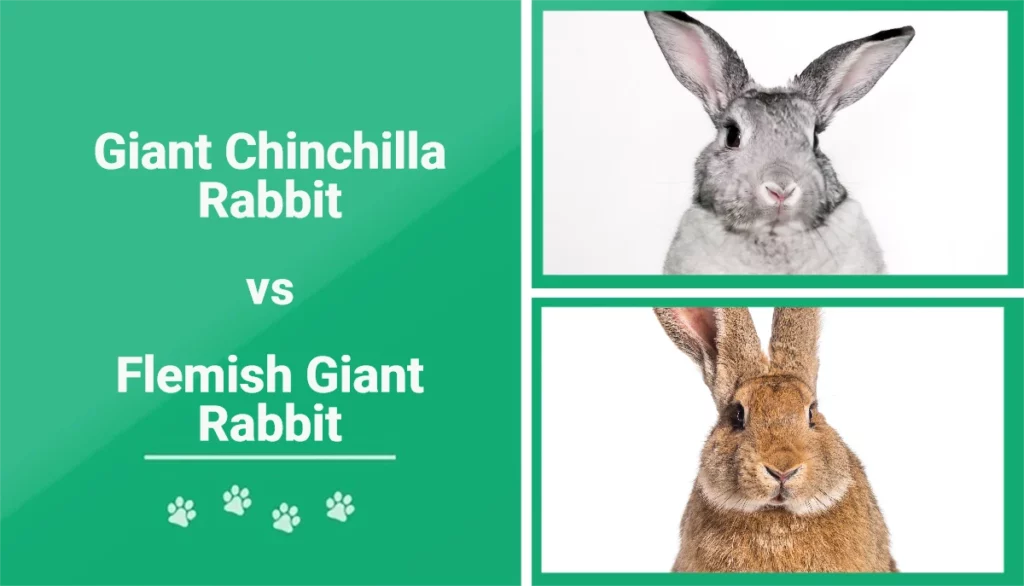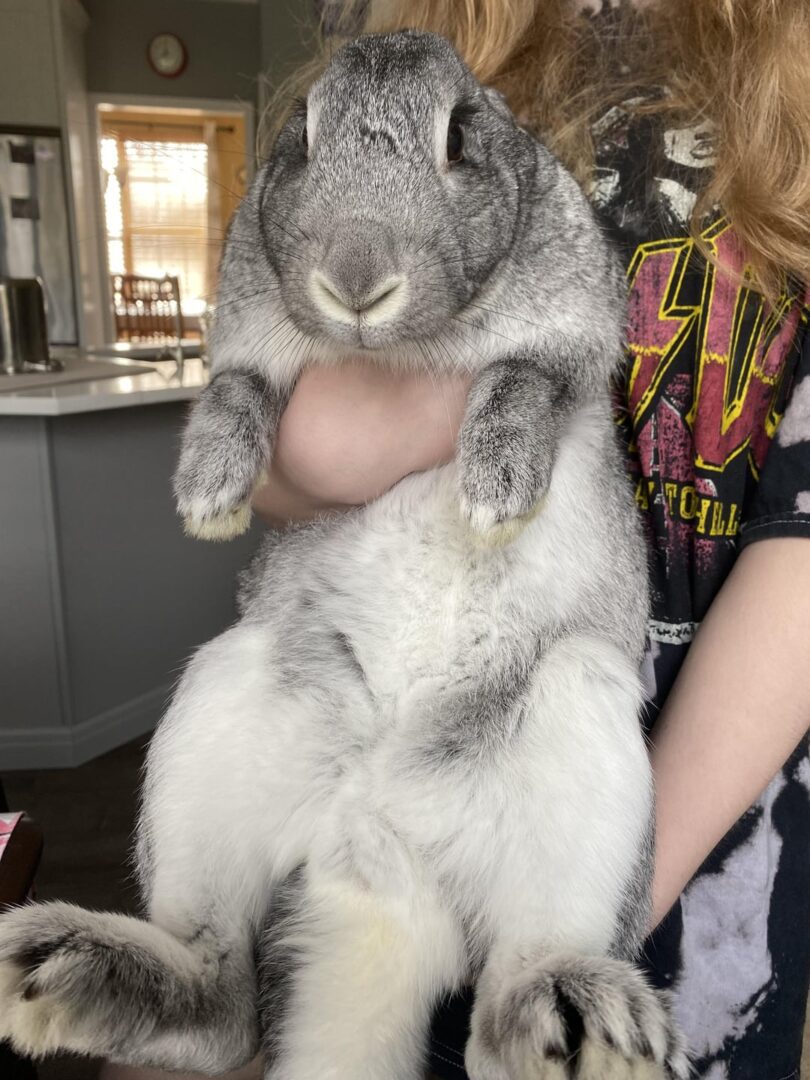Key Takeaways
- The Giant Chinchilla rabbit is a large, friendly breed, typically weighing between 12 and 16 pounds.
- Adoption costs can range from $50 to $100, with ongoing care expenses including housing, food, and veterinary care.
- This breed is known for its soft, dense, blue-grey coat, which requires regular grooming to maintain.
- Giant Chinchillas are generally docile and make great pets for families with older children.
- While they can live with other rabbits, special care must be taken when introducing them to smaller breeds.
The Appeal of Adopting a Giant Chinchilla Rabbit
When it comes to adopting a pet rabbit, the Giant Chinchilla rabbit stands out for its unique charm and characteristics. Developed in the United States in 1921, this breed was created by crossing a Flemish Giant with a Chinchilla rabbit. The result is a rabbit that combines the best traits of both breeds, making it an appealing choice for many pet enthusiasts.

“a Chinchilla Dwarf …” from www.reddit.com and used with no modifications.
Unique Characteristics of the Giant Chinchilla Rabbit
“The Giant Chinchilla rabbit is the only rabbit of the Chinchilla family with a flyback coat.”
One of the standout features of the Giant Chinchilla rabbit is its size. These rabbits typically weigh between 12 and 16 pounds, with a semi-arched body shape and powerful legs. They have a soft white underbelly and medium-length ears that add to their distinctive appearance.
Besides their impressive size, Giant Chinchillas are known for their soft, dense, blue-grey coat. This unique coat not only adds to their visual appeal but also requires regular grooming to keep it in top condition. The coat’s flyback nature means that it quickly returns to its original position when stroked, a feature that is quite unique among rabbit breeds.
Costs, Availability, and Rarity in the Adoption World
Adopting a Giant Chinchilla rabbit can be a rewarding experience, but it’s important to understand the costs and availability involved. Typically, adoption fees for these rabbits range from $50 to $100. However, the ongoing expenses, such as housing, food, and veterinary care, should also be considered.
In terms of availability, Giant Chinchillas are relatively rare compared to other rabbit breeds. This rarity can make them more challenging to find, but their unique characteristics make the search worthwhile for many enthusiasts. Adoption from a reputable breeder or rescue organization is recommended to ensure the health and well-being of the rabbit.
Why Enthusiasts Are Drawn to Giant Chinchillas
The Giant Chinchilla rabbit’s gentle and friendly nature is a major draw for potential adopters. These rabbits are known for their docile temperament, making them excellent companions for families, singles, and seniors alike. Their playful yet calm demeanor means they enjoy spending time outside of their cage, interacting with their human companions.
Moreover, the Giant Chinchilla’s unique appearance and size make them a fascinating pet to own. Their distinctive coat and large size set them apart from other rabbit breeds, and their affectionate nature makes them a beloved addition to any household.
Understanding the Size and Appearance of Giant Chinchillas
The Giant Chinchilla rabbit’s size and appearance are among its most notable features. Understanding these aspects is crucial for potential adopters to ensure they can provide the appropriate care and environment for these gentle giants.
Average Size and Body Structure
As the name suggests, Giant Chinchillas are a large breed. Adult rabbits typically weigh between 12 and 16 pounds, although some females may weigh slightly more than males. They have a semi-arched body shape, with strong legs and feet that support their size. This robust build gives them a commanding presence, while their gentle nature ensures they are approachable and friendly.
Distinctive Coat and Color Patterns
The coat of the Giant Chinchilla rabbit is one of its most striking features. The dense, blue-grey fur is soft to the touch and requires regular grooming to maintain its condition. This coat not only adds to their aesthetic appeal but also provides protection against the elements, making them well-suited to various environments. For those interested in learning more about the adoption journey of pets, from shelter to sofa, exploring further resources can be beneficial.

“Giant Chinchilla Rabbit vs. Flemish …” from pangovet.com and used with no modifications.
Comparison to Other Giant Rabbit Breeds
When compared to other giant rabbit breeds, the Giant Chinchilla holds its own in terms of size and temperament. While the Flemish Giant, for example, can weigh up to 50 pounds, the Giant Chinchilla offers a more manageable size for many households. Additionally, their docile nature makes them easier to handle and more adaptable to different living situations.
Overall, the Giant Chinchilla rabbit’s unique combination of size, appearance, and temperament makes it a standout choice for those considering adopting a large rabbit breed.
Dietary Needs for Optimal Health
Feeding a Giant Chinchilla rabbit requires careful attention to their dietary needs to ensure they stay healthy and happy. The cornerstone of their diet should be high-quality hay, which helps maintain their digestive health and prevents hairballs. Hay is not only a source of fiber but also keeps their teeth from overgrowing, which is crucial for their well-being.
In addition to hay, fresh vegetables and a small amount of rabbit pellets can be included in their diet. Leafy greens like romaine lettuce, kale, and parsley are excellent choices. It’s important to introduce new foods gradually and monitor for any adverse reactions. Fresh water should always be available to keep them hydrated.
Grooming Tips for a Healthy Coat
The soft, dense coat of a Giant Chinchilla rabbit requires regular grooming to keep it in pristine condition. Grooming helps prevent matting and reduces the risk of hairballs, which can be a concern due to their dense fur. A weekly brushing session is usually sufficient, but during molting periods, you may need to brush them more frequently to manage the increased shedding. For those interested in other rabbit breeds with unique grooming needs, consider learning about the Angora rabbit.
Using a slicker brush or a grooming mitt can help remove loose fur and keep their coat looking its best. It’s also an excellent opportunity to check for any signs of skin issues or parasites. Regular grooming not only maintains their appearance but also strengthens the bond between you and your rabbit.
Besides brushing, keep an eye on their nails and trim them as needed to prevent overgrowth. This is especially important for indoor rabbits, as they may not naturally wear down their nails as outdoor rabbits do.
Health Concerns and Prevention Strategies
Giant Chinchilla rabbits, like all rabbits, can be prone to certain health issues, but with proper care, many of these can be prevented. Regular veterinary check-ups are essential to catch any potential problems early. Common health concerns include dental issues, gastrointestinal stasis, and respiratory infections.
To prevent dental issues, ensure they have plenty of hay to chew on, which helps keep their teeth in check. For gastrointestinal health, a diet rich in fiber and low in sugars is crucial. If you notice any changes in their eating habits or droppings, it’s important to consult a veterinarian promptly.
Keeping their living environment clean and well-ventilated can help prevent respiratory infections. Regular cleaning of their enclosure and providing fresh bedding are simple yet effective measures to ensure their overall health.
Exploring the Temperament of Giant Chinchillas
The temperament of the Giant Chinchilla rabbit is one of its most endearing qualities. Known for their calm and gentle nature, these rabbits make excellent companions for families and individuals alike. Understanding their behavior patterns and how they interact with humans and other pets can help you create a harmonious living environment.
Nature and Behavior Patterns
Giant Chinchillas are generally laid-back and enjoy a relaxed lifestyle. They are not overly active but do appreciate some time outside of their enclosure to explore and interact. Their playful nature can be encouraged with toys and safe spaces where they can hop around. For those considering bringing a Giant Chinchilla into their home, it’s important to understand the rescue pet home preparation guide to ensure a smooth transition.
These rabbits are known for being social creatures, often forming strong bonds with their human companions. They enjoy gentle handling and can be quite affectionate, making them a delightful addition to any home. However, they may be a bit shy initially, so patience and gentle handling are key to building trust. For tips on how to prepare your home for a new pet, check out this home preparation guide.

Interactions with Humans and Other Pets
Giant Chinchillas generally get along well with humans, including children, as long as interactions are supervised and respectful. They are not typically aggressive, but like all animals, they can become stressed if handled roughly. Teaching children how to interact with them gently can help foster a positive relationship. For more information on this breed, you can visit the Giant Chinchilla rabbit guide.
When it comes to other pets, Giant Chinchillas can coexist with other rabbits, provided introductions are done gradually and carefully. However, care must be taken if introducing them to smaller rabbit breeds, as their size can be intimidating. Monitoring their interactions and providing separate spaces if needed can help maintain harmony.
Training and Socialization Techniques
Training a Giant Chinchilla rabbit is possible and can be a rewarding experience. They can learn simple commands and even use a litter box with patience and consistency. Positive reinforcement, such as treats and praise, can encourage desired behaviors.
Socializing your rabbit from a young age is important to ensure they are comfortable with handling and new experiences. Regular interaction with different people and environments can help them become well-adjusted and confident. Remember, each rabbit is unique, so tailor your approach to their individual personality and needs.
Pros and Cons of Owning a Giant Chinchilla Rabbit
Like any pet, owning a Giant Chinchilla rabbit comes with its own set of advantages and challenges. Understanding these can help you make an informed decision about whether this breed is the right fit for your lifestyle.
Benefits of Adopting a Giant Chinchilla
One of the biggest advantages of adopting a Giant Chinchilla is their gentle and friendly nature. They are known for being easy-going and affectionate, making them great companions for families, singles, and seniors alike. Their unique appearance and large size also make them a fascinating pet to own.
Additionally, their docile temperament means they are generally easy to handle and care for. With proper socialization, they can adapt well to different living situations and enjoy interacting with their human companions. Their playful yet calm demeanor adds to their appeal as a pet.
Challenges and Considerations for Potential Owners
While there are many benefits to owning a Giant Chinchilla, there are also challenges to consider. Their large size means they require more space than smaller rabbit breeds, so providing a suitable enclosure and exercise area is essential. This can be a consideration for those with limited space.
Additionally, their dense coat requires regular grooming to prevent matting and maintain its condition. Potential owners should be prepared for the time and effort involved in their care, including regular veterinary check-ups and a proper diet to prevent health issues.
Overall, while Giant Chinchillas make wonderful pets, they require commitment and care to ensure they thrive in a home environment. Assessing your ability to meet their needs is crucial before bringing one into your family.
Are Giant Chinchillas Suitable for You?
Deciding if a Giant Chinchilla rabbit is the right pet for you involves considering several factors. Their large size and friendly nature make them a delightful companion, but they do require ample space and attention. If you have the room and time to dedicate to their care, they can be a wonderful addition to your home.
These rabbits thrive in environments where they can interact with their human companions and have space to explore. If you enjoy spending time with your pets and are willing to invest in their care, a Giant Chinchilla could be a great fit. However, if you have limited space or time, you might want to consider a smaller breed.
Giant Chinchillas Living with Other Rabbits
When considering a multi-rabbit household, it’s essential to understand how Giant Chinchillas interact with other rabbits. Their size and temperament play a significant role in their compatibility with other breeds. For those interested in adopting, it’s important to prepare your home properly, and you can find a helpful home preparation guide to ensure a smooth transition.
Compatibility with Smaller Rabbit Breeds
“Giant Chinchilla rabbits can’t live with other smaller breed rabbits because they need distinct care and attention.”
While Giant Chinchillas can coexist with other rabbits, special care must be taken when introducing them to smaller breeds. Their size can be intimidating, and they require distinct care and attention. It’s important to ensure that the smaller rabbit feels safe and not threatened by the presence of a larger companion. For more tips on preparing your home for new pets, check out this home preparation guide.
In some cases, it may be best to house them separately while allowing supervised interactions. This can help prevent any potential stress or aggression between the rabbits.
Steps to Introduce New Rabbit Companions
Introducing a new rabbit companion requires patience and careful planning. Here are some steps to help facilitate a smooth introduction:
- Start by placing the rabbits in separate enclosures where they can see and smell each other without direct contact.
- Gradually increase their exposure to each other by allowing them to explore a neutral space together under supervision.
- Observe their behavior closely for any signs of aggression or stress. If necessary, separate them and try again later.
- Provide each rabbit with their own space, food, and water to prevent resource guarding.
- Continue supervised interactions until both rabbits are comfortable with each other’s presence.
Monitoring and Ensuring Harmony in Multi-Rabbit Homes
Once your rabbits have been successfully introduced, it’s important to monitor their interactions regularly. Look for signs of bonding, such as grooming each other or resting together, which indicate a positive relationship. For more information on different rabbit breeds, you can explore the differences between Giant Chinchilla and Flemish Giant rabbits.
If any aggressive behavior arises, separate the rabbits immediately and consult with a veterinarian or animal behaviorist for guidance. Ensuring each rabbit has enough space and resources can help maintain harmony in a multi-rabbit household.
Frequently Asked Questions (FAQ)
To help you better understand the care and requirements of Giant Chinchilla rabbits, here are answers to some frequently asked questions:
What is the lifespan of a Giant Chinchilla rabbit?
Giant Chinchilla rabbits typically have a lifespan of 5 to 8 years. With proper care, including a healthy diet, regular veterinary check-ups, and a safe living environment, they can live longer, sometimes reaching up to 10 years.
How much does it cost to adopt and care for a Giant Chinchilla?
The initial adoption fee for a Giant Chinchilla rabbit can range from $50 to $100. However, ongoing care expenses such as housing, food, grooming supplies, and veterinary care should also be considered. Expect to spend around $500 to $1,000 annually on their care. For a broader understanding of pet adoption costs, you might find this article on calico cats adoption cost informative.
Would Giant Chinchillas make a good house pet?
Yes, Giant Chinchillas can make a nice addition to your household. They enjoy spending time with their human companions and can adapt well to indoor living, in fact it is safer for them and most rabbit rescue orgs advocate for rabbits to be kept inside a home not outside like cattle (even though they are related to horses). Ensure they have enough space to move around and explore, and provide them with plenty of mental stimulation and social interaction.
What should I do if my rabbit shows signs of aggression?
If your Giant Chinchilla rabbit shows signs of aggression, such as biting or lunging, it’s important to identify the cause. Stress, fear, or health issues can trigger aggressive behavior. Consult with a veterinarian to rule out any medical concerns and consider working with an animal behaviorist to address behavioral issues.


